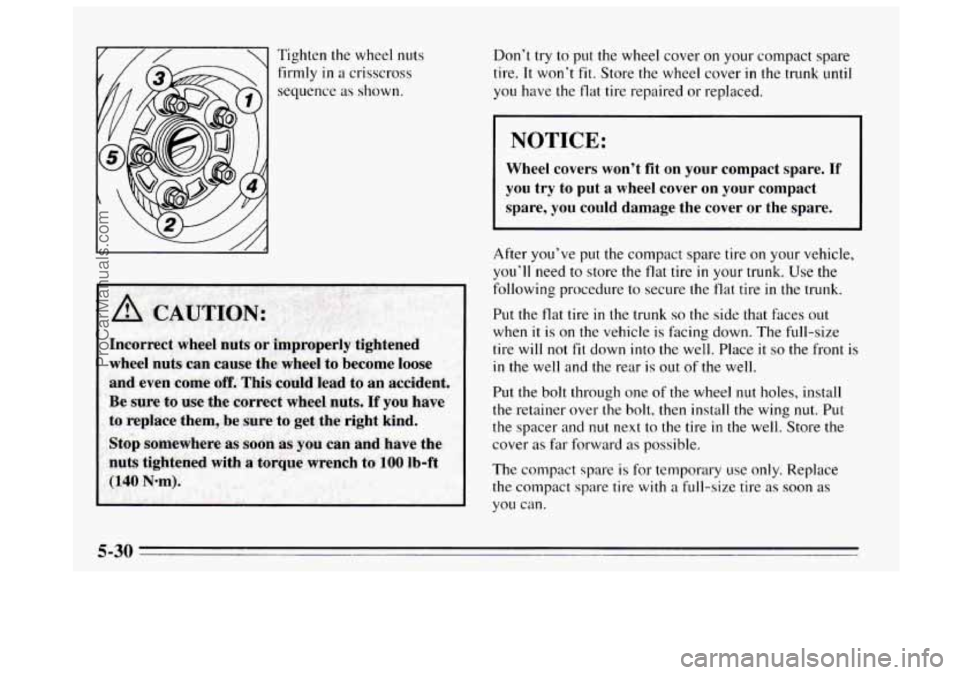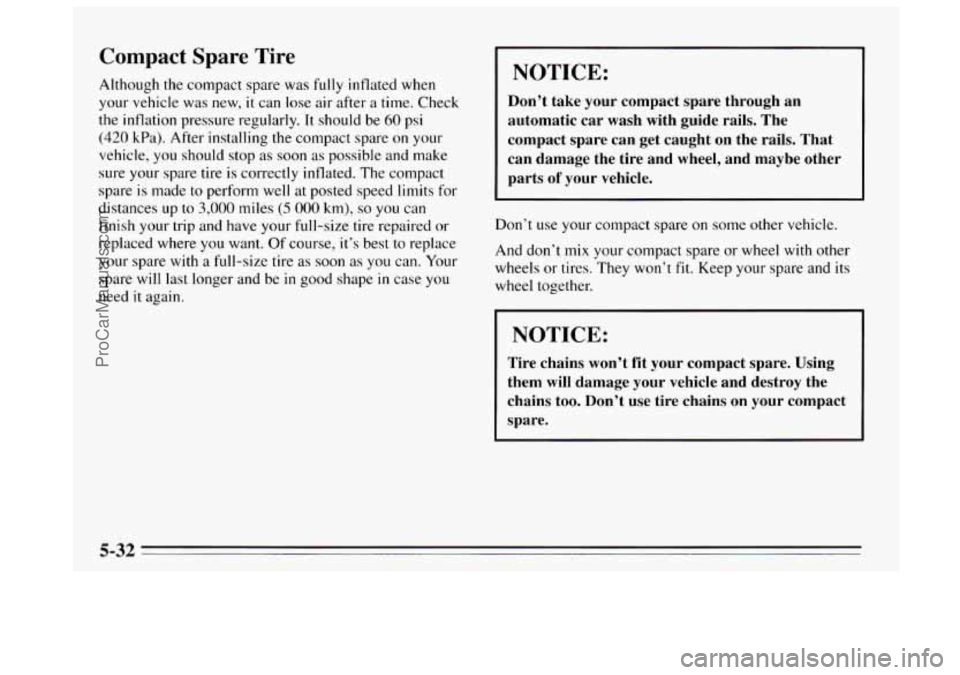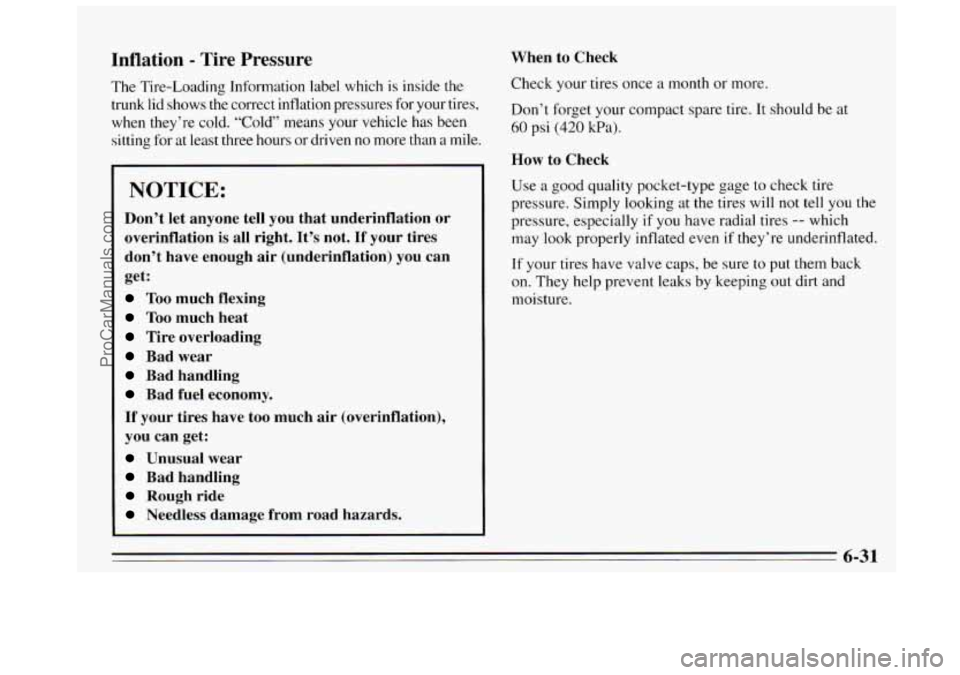Page 199 of 340
The following steps will tell you how to use the jack and
change a tire. The
equipment you’ll need
is in the trunk. Pull the
carpeting from the floor
of
the trunk. Turn the center
nut on the compact spare
cover counterclockwise to
remove it. Then lift and
remove the cover.
Turn the wing nut
counterclockwise and
remove it. Then lift
off the
spacer and remove the spare
tire.
5-25
ProCarManuals.com
Page 201 of 340
Using the wheel wrench, loosen all the wheel nuts.
Don’t remove
them yet.
A CAUTION:
Getting under a vehicle when it is jacked up is
dangerous. If the vehicle slips off the jack, you
could be badly
injured or killed. Never get under
a vehicle when it is supported only by a jack.
Turn the jack handle clockwise to raise the jack lift head
a few inches.
Position
the jack under the
vehicle and raise the jack
lift head until it fits firmly
into the notch in the
vehicle’s frame nearest the
flat tire.
Put the compact spare tire near
you.
NOTICE:
Raising your vehicle with the jack improperly
positioned will damage the vehicle
or may allow
the vehicle to fall off the jack.
Be sure to fit the
jack lift head into the proper location before
raising your vehicle.
- 5-27
ProCarManuals.com
Page 202 of 340
Raise the vehicle by turning the jack handle clockwise.
Raise the vehicle far enough off
the ground for the spare
tire to
fit under the vehicle. Remove all wheel nuts and
take off the flat tire.
5-28
ProCarManuals.com
Page 204 of 340

Tighten the wheel nuts firmly
in a crisscross
sequence as shown. Don’t
try
to put the wheel cover on your compact spare
tire. It won’t
fit. Store the wheel cover in the trunk until
you have the flat tire repaired or replaced.
I NOTICE:
Wheel covers won’t fit on your compact spare. If
you try to put a wheel cover on your compact
spare, you could damage the cover or the spare.
After you’ve put the compact spare tire on your vehicle,
you’ll need to store the flat tire
in your trunk. Use the
following procedure to secure
the flat tire in the trunk.
Put the flat tire
in the trunk so the side that faces out
when it is
on the vehicle is facing down. The full-size
tire will not fit down
into the well. Place it so the front is
in the well and the rear is out of the well.
Put the bolt through one
of the wheel nut holes, install
the retainer over the bolt, then install the wing
nut. Put
the spacer and
nut next to the tire in the well. Store the
cover
as far forward as possible.
The compact spare is for temporary use only. Replace
the compact spare tire
with a full-size tire as soon as
you can.
5-30
ProCarManuals.com
Page 205 of 340
See “Compact Spare Tire” in the Index. See the storage
instructions label to replace your compact spare into
your trunk properly. I
27 *’
1.
2.
3
4
5.
6.
7.
8.
9.
10.
Nut
Cover
Wing Nut
Spacer
Tire
Wrench Nut
Retainer
Jack
Bolt
5-31
ProCarManuals.com
Page 206 of 340

Compact Spare Tire
Although the compact spare was fully inflated when
your vehicle was
new, it can lose air after a time. Check
the inflation pressure regularly. It should be 60 psi
(420 kPa). After installing the compact spare on your
vehicle, you should stop
as soon as possible and make
sure your spare tire
is correctly inflated. The compact
spare is made
to perform well at posted speed limits for
distances
up to 3,000 miles (5 000 km), so you can
finish your trip and have your full-size tire repaired or
replaced where you want.
Of course, it’s best to replace
your spare with
a full-size tire as soon as you can. Your
spare will last longer and be in good shape
in case you
need it again.
1 NOTICE:
Don’t take your compact spare through an
automatic
car wash with guide rails. The
compact spare can get caught on the rails. That
can damage the tire and wheel, and maybe other
parts
of your vehicle.
Don’t use your compact spare on some other vehicle.
And don’t mix your compact spare or wheel
with other
wheels or tires. They won’t
fit. Keep your spare and its
wheel together.
NOTICE:
Tire chains won’t fit your compact spare. Using
them will damage your vehicle and destroy the
chains too. Don’t use tire chains on your compact
spare.
5-32
ProCarManuals.com
Page 238 of 340
Tires
We don’t make tires. Your new vehicle comes with
high-quality tires made by a leading tire manufacturer.
These tires are warranted by the tire manufacturers and
their warranties are delivered with every new Buick.
If
your spare tire is a different brand than your road tires,
you will have a tire warranty folder from each
of these
manufacturers.
ProCarManuals.com
Page 239 of 340

Inflation - Tire Pressure
The Tire-Loading Information label which is inside the
trunk lid shows the correct inflation pressures for your tires,
when they’re cold. “Cold” means your vehicle has been
sitting for at least three hours or driven no more than a mile.
NOTICE:
Don’t let anyone tell you that underinflation or
overinflation is all right. It’s not.
If your tires
don’t have enough
air (underinflation) you can
get:
Too much flexing
Too much heat
Tire overloading
Bad wear
Bad handling
Bad fuel economy.
If your tires have too much air (overinflation),
you can get:
Unusual wear
Bad handling
Rough ride
Needless damage from road hazards. When to Check
Check
your tires once a month or more.
Don’t forget your compact spare tire. It should be at
60 psi (420 kPa).
How
to Check
Use a good quality pocket-type gage to check tire
pressure. Simply looking at the tires will
not tell you the
pressure, especially
if you have radial tires -- which
may look properly inflated even if they’re underinflated.
If your tires have valve caps, be sure
to put them back
on. They help prevent leaks by keeping out dirt and
moisture.
6-31
ProCarManuals.com